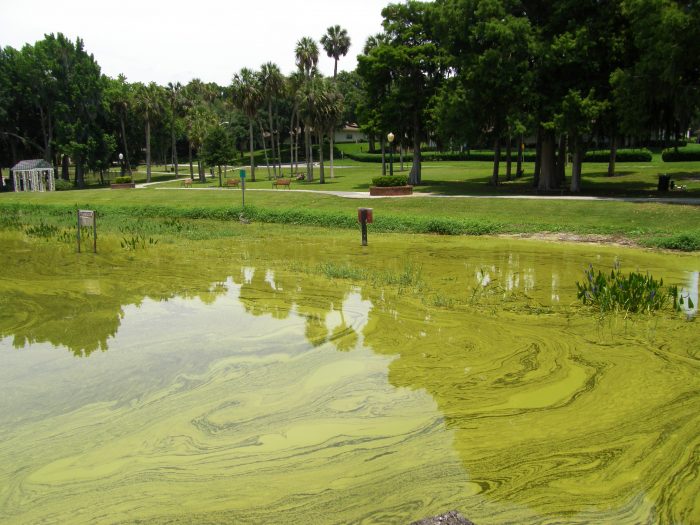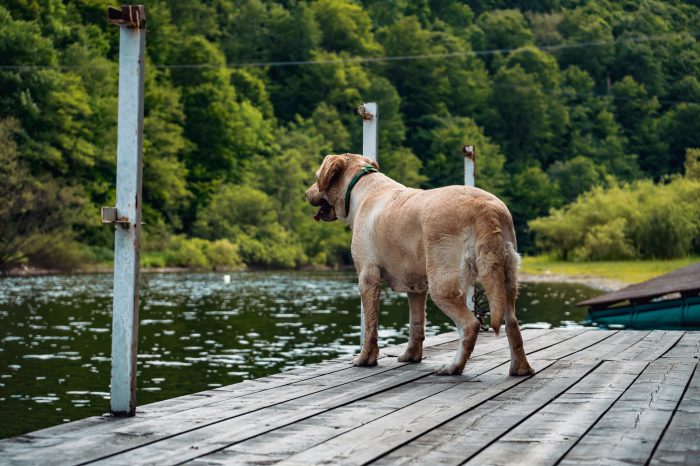Harmful Algal Blooms (HABs) and Pets: Know the Facts

A lake entirely covered by an algal bloom. As a good rule of thumb, “When in Doubt, Stay Out!”
Pets and Cyanobacteria
Recent news stories highlight the danger that Harmful Algal Blooms (HABs) pose to people and pets. These blooms are caused by organisms known as cyanobacteria, also referred to as blue-green algae, and can deprive ecosystems of oxygen, block sunlight, and in some cases produce potent toxins that lead to illness or even death in wildlife, livestock, companion animals, and humans.
HABs typically peak in late summer when warm temperatures, abundant sunlight, and elevated nutrient levels converge. They often manifest as a thick green scum or paint-like layer on the water’s surface, sometimes giving it an oily sheen or turning the entire body of water green. Other blooms are subtler—resembling floating pollen, creating murky waters, or occurring just below the surface.

Since pets are smaller than humans, they are at a higher risk of contact with HABs, and symptoms in pets will appear at much lower dosages. Pets are also more likely to ingest algae or toxins as they drink the water, which increases the rate at which toxins are absorbed by the body. For their safety, pets should not be allowed to swim in any water with signs of an algal bloom or drink any standing water.
Testing for Cyanobacteria and Toxins
Several common toxins are produced by various cyanobacteria species, but not every species produces every toxin, and there is no way to tell by looking at a bloom whether it is toxic. Some species only produce one specific toxin, and some produce several different toxins, depending on environmental conditions.
EnviroScience provides a variety of Harmful Algal Bloom services, including toxicity testing and algal identification. EnviroScience usually recommends a “HAB screen” test for a pet owner who is concerned about their pet swimming in a home pond or lake. EnviroScience biologists will check your sample for any cyanobacterial species that can produce toxins. We provide you a report listing these species and any toxins that they can produce. EnviroScience staff can then recommend which, if any, of the toxins you should test for, based on which species are dominant in the sample.
For more information, contact us to discuss pricing and schedule a test using the form below.
Few environmental firms in the country retain EnviroScience’s degree of scientific know-how, talent, and capability under one roof. The diverse backgrounds of our biologists, environmental engineers, scientists, and divers enable us to provide comprehensive in-house services and an integrated approach to solving environmental challenges—saving clients time, reducing costs, and ensuring high-quality results.
Our client guarantee is to provide “Excellence in Any Environment,” meaning no matter what we do, we will deliver on our Core Values of respect, client advocacy, quality work, accountability, teamwork, and safety. EnviroScience was created with the concept that we could solve complex problems by empowering great people. This concept still holds true today as our scientists explore the latest environmental legislation and regulations and incorporate the most up-to-date technology to gather and report data.
EnviroScience expertise includes but is not limited to aquatic surveys (including macroinvertebrate surveys and biological assessments); ecological restoration; ecological services (including impact assessments, invasive species control, and water quality monitoring); emergency response; engineering and compliance services; endangered mussel surveys; laboratory and analysis; stormwater management; sustainability services; threatened and endangered species; and wetlands and streams (including delineation and mitigation). Further, EnviroScience is one of the few biological firms in the country that is a general member of the Association of Diving Contractors International (ADCI) and offers full-service commercial diving services.